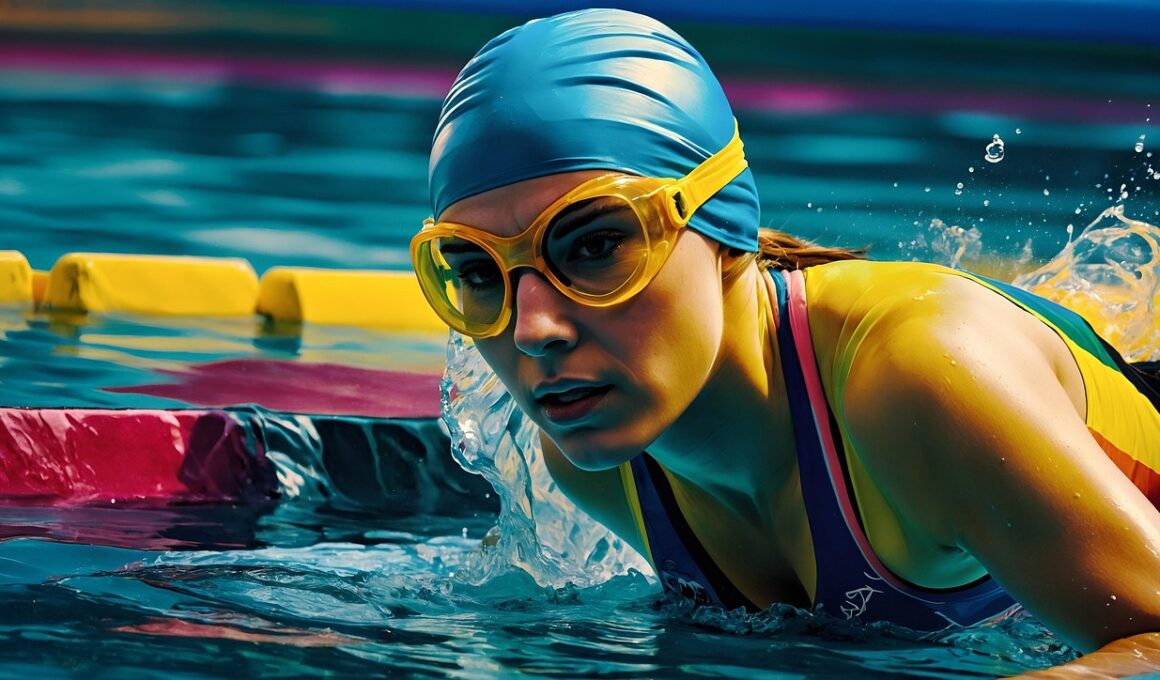Top 10 Innovative Swim Gadgets for Competitive Swimmers
Competitive swimming has gradually evolved due to innovations in swim gadgets and technology. Athletes strive to find tools that enhance their performance by providing valuable feedback during training and competition. One such innovation is the swim cap equipped with sensors that track an athlete’s speed, stroke count, and lap times. These smart caps sync with mobile devices, offering insights that help swimmers refine their techniques. Another remarkable gadget is the swim watch, which combines functionality with style. Swimmers can measure their heart rate, calculate stroke efficiency, and analyze their performance in real time. Additionally, swim goggles with heads-up displays are gaining traction, allowing swimmers to see their lap data without losing speed. They’re designed to project key metrics right in the lens. Furthermore, underwater drones have also gained popularity among elite swimmers for observation and technique analysis. These drones provide a unique viewpoint or perspective, enabling coaches and athletes to scrutinize dives, turns, and strokes. In summary, the integration of technology into swimming is remarkably shaping competitive practices.
The next groundbreaking technology is the use of resistance bands designed explicitly for swim training. Resistance bands add a layer of difficulty during practice, helping swimmers build strength and improve endurance. These bands attach to the swimmer’s waist and are anchored to a fixed point on shore. Swimmers experience enhanced drag while performing their strokes, which leads to increased muscle growth and improved technique. Another useful gadget comes in the form of smart pool sensors. These sensors are placed in the water to track various metrics including stroke efficiency and turn times, then relay this information to coaches in real-time. This provides immediate feedback to pinpoint areas for improvement. Swim training fins are also evolving, with some now featuring adjustable stiffness settings. These fins allow swimmers to customize their workouts, targeting speed or endurance as needed. Alongside this, buoyancy devices such as flotation belts are being refined to allow swimmers to maintain technique while still receiving assistance. The adaptability of these gadgets ensures that every swimmer can find the right tool tailored for their unique training regimen and goals.
Wearable Swimming Technology
Wearable technology continues to revolutionize the swimming experience, integrating the latest advancements in sensor technology. High-tech swimsuits now come fitted with sensors that monitor overall body movement, giving swimmers crucial data about their body positioning in water. Furthermore, these suits can provide insight into hydrodynamics, helping swimmers improve their drag and streamline form. Heart rate monitors are another excellent addition for swimmers wanting to track their physiological responses during workouts. These devices ensure that training remains effective by keeping heart rates within optimal ranges for fat-burning and endurance training. Additionally, lap counting devices have gained popularity, eliminating the need for manual counting during training sessions. They utilize underwater sensors that automatically track laps, allowing swimmers to focus solely on their technique. Speedometers are also essential wearables, measuring current speed and average pace throughout swimming sessions. These gadgets offer swimmers critical feedback, ensuring they maintain their training targets. The continuous innovation in wearable swim technology is undeniable, enabling athletes to elevate their performance and ultimately reach their competitive goals.
Underwater cameras have started to make waves in swim training as well. These compact cameras are commonly used by coaches to film swimmers from multiple angles, capturing their strokes and techniques in detail. The footage can then be analyzed to provide visual feedback, which is often more effective than verbal cues alone. Furthermore, the rise of virtual reality (VR) systems tailored to swim training is gaining momentum. With VR technology, swimmers can experience realistic scenarios simulating races or challenging conditions without leaving the pool. This immersive approach not only helps swimmers mentally prepare for competitions but also fosters confidence and improves decision-making skills critical during races. Smart swim towels are yet another innovative concept; they integrate technology that allows swimmers to track their training metrics through a small embedded sensor. Swimmers can simply wipe down their faces after a session and receive instant feedback on performance metrics afterward. This gadget offers a seamless and unobtrusive way for athletes to analyze their training. Yet, the combination of these technologies is pushing the boundaries of what’s possible in competitive swimming.
Swim Training Aids
Innovation extends into training aids as well, with many companies designing advanced kickboards that enhance stroke performance. Unlike traditional kickboards, these new models come with adjustable buoyancy, allowing swimmers to change resistance levels based on their training needs. Tempo trainers are also essential tools that help swimmers work on their timing and cadence. These devices emit rhythmic beeps that swimmers match their strokes to, effectively training them to maintain an optimal pace and improve overall efficiency. Another notable aid is the snorkel designed specifically for swimming, which allows breath control while eliminating the need to turn the head. This freedom promotes proper body positioning and reduces drag. Swim paddles have also seen advancements, with various shapes and sizes to cater to different stroke styles. Customizable paddles allow swimmers to experiment with their hand movements and gather precise data on their stroke power. Alongside these, pull buoys continue to evolve, providing versatile support for swimmers seeking to isolate their arm movements. This varied selection of innovative training aids ensures that competitive swimmers have plenty of options to enhance their performance.
The world of competitive swimming is indeed fascinating, with technological advancements continually reshaping training methods. The integration of smart devices, tracking tools, and interactive systems enhances not only the technique but also the sport’s enjoyment for many athletes. For instance, smart swim headphones bring a new dimension to training by allowing swimmers to listen to music while staying aware of their surroundings. This helps improve motivation and focus during grueling workout sessions. Fitness apps specifically designed for swimmers have become essential companions, aggregating complex performance data and allowing swimmers to track progress over time. These apps often provide tailored training programs based on user stats and goals. Additionally, smart swim fins equipped with sensors are emerging, offering insights into leg stroke effectiveness and changing water dynamics. With so many options available, athletes can select gadgets that suit individual training requirements. From analytics to performance improvement, these high-tech gadgets help competitive swimmers maintain their edge in modern swimming. As technology continues to evolve, it’s clear that innovative swim gadgets will play an essential role in shaping the future of the sport.
Looking Forward with Technology
As we look ahead, the future of swim gadgets and technology seems promising. With innovations in materials and data analytics, athletes can expect even more accurate data collection and feedback mechanisms during their training. The growing popularity of machine learning algorithms will allow for personalized training regimens based on individual performance. Moreover, wearable tech is expected to evolve further, making use of advanced biometric sensors that provide a holistic view of a swimmer’s physical condition. This will not only enhance performance monitoring but also improve overall athlete well-being. As competitive swimming becomes more data-driven, athletes will increasingly rely on predictive analytics to inform their training strategies. Additionally, the integration of artificial intelligence in swim training could lead to adaptive learning, where training routines adjust in response to daily performance metrics and recovery status. All in all, the combination of these emerging technologies presents a future where competitive swimming training will be not only more effective but also more enjoyable for swimmers of all levels. As the sport continues to embrace these advances, participants must remain agile to harness the benefits for achievement and success in competitions.
In conclusion, the rise of innovative swim gadgets for competitive swimmers has transformed the landscape of training and performance assessment. With tools tailored for every aspect of swimming, these advancements empower athletes to hone their skills with precision. From smart caps and wearable technology to immersive training experiences and performance analytics, the integration of innovation has truly shaped modern swimming. The future promises further enhancements, setting the stage for even more groundbreaking developments. As competitive swimmers continue to embrace these cutting-edge technologies, the potential for personal bests keeps expanding. The commitment of companies to innovate in swim technology will undoubtedly keep pushing the boundaries of what is achievable in the pool, encouraging athletes to dream big. By leveraging these tools, swimmers can achieve their utmost potential and take their training and performance to unprecedented heights. Therefore, the impact of these innovations is not merely a trend but a significant shift that will continue shaping the future of swimming competitions.


